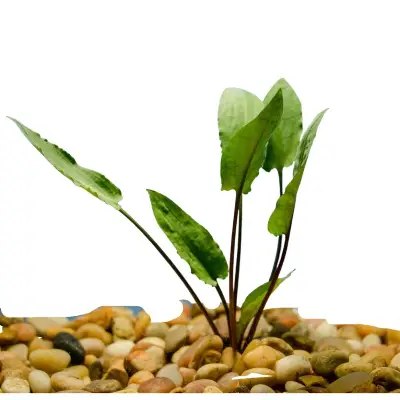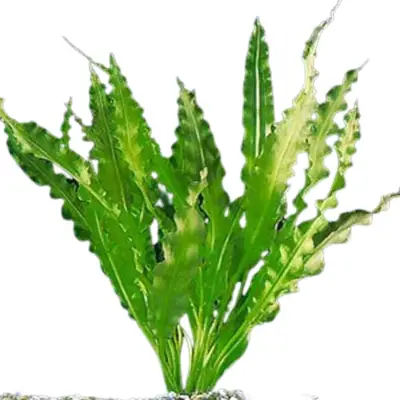Affiliate Disclaimer:
FishKeepingAnswers.com is reader-supported. When you buy through links on our site we may earn a commission.
When you are first starting out with aquarium plants, it can be very daunting. All of the species listed below are perfect for the first-time aquaculturist (aquarium plant grower). Plants make an amazing addition to any aquarium. Not only do they look great, but they help keep the water clean by absorbing harmful fish waste. Once you start growing plants, you’ll want more and more. They are addictive!
Planted aquariums are my first love. A number of the tanks in my fish room are heavily planted with the focus first on the plants, with the fish coming as an afterthought. In my local fish club, I am classed as a Master Aquatic Horticulalist due to the number of plants I have grown over the years. These days I tend to stick to half a dozen different varieties.
13 Aquarium Plants Suitable For Beginners
- Cryptocoryne wendtii green
- Marimo Moss Ball
- Aponogeton Crispus
- Java Moss
- Susswassertang
- Amazon Sword
- Java Fern
- Cryptocoryne Lutea
- Bacopa Caroliniana
- Dwarf Sagittaria
- Vallisneria
- Pogostemon Stellatus Octopus
- Anubias Golden
What Are An Aquatic Plants Basic Needs?
- Water: All plants on the planet require water in some way or form. For aquatic plants this need is clearly greater than terrestrial plants. Many aquatic plants require water to physically support their weight and all of them use water as a way to deliver nutrients to either their leaves or roots, or both.
- Light: As with water, all plants require light. The difference is, they require it in different quantities. This is where we start to get the distinction between a ‘beginner friendly’ plant and one which is suitable for someone with a more advanced setup. Many aquatic plants, and most of the ones on my list here, will grow with a basic light setup (such as the Fluval Aquasky). A basic shop light with a fluorescent bulb in it is sufficient. For other plants, a high powered LED light offering a full spectrum of light is needed.
- Nutrients: Plants require nutrients to grow. The three main nutrients, sometimes referred to as ‘macronutrients’ are nitrogen, phosphorus, and potassium (NPK for short). All plants need these 3 nutrients. In addition, they also need other nutrients, often referred to as ‘micronutrients’, or trace elements. These nutrients are needed in much smaller quantities and include iron (Fe), manganese (Mn), chlorine (Cl), copper (Cu), boron (B), molybdenum (Mo), cobalt (Co), nickel (Ni).
- CO2 (Carbon Dioxide): Aquarium plants use the process of photosynthesis to convert Carbon Dioxide (CO2) in the aquarium water into Oxygen. Some aquatic plants are happy to use the CO2 naturally present in your aquarium water, whereas other plants require CO2 to be ‘injected’ into the aquarium by the aquarist. All plants on my list here are happy to use whatever CO2 is naturally present in the aquarium water.
- Substrate: With the exception of floating plants and one or two plants that prefer to grow attached to rocks or wood, plants require a substrate to send their roots down into. The substrate should be heavy enough it keeps the plants down, but light enough the plants can spread their roots throughout it. I have had great success using Fluval Stratum, which is a substrate designed especially with plants in mind.
Easy Plants – Great For Beginners:
- Easy plants will grow and thrive with minimum care
- Low maintenance plants, great for beginners or low tech tanks
- Low light plants require fewer watts per gallon
- CO2 injection is not required
Medium Plants – For Those With A Little More Experience:
- Medium plants require at little more light per gallon to thrive
- Most plants require a CO2 supply to help plants grow with good colour and density
- Liquid fertilizers are required
- Additional weekly maintenance required to keep plants growing well
Hard Plants – Plants For Those With Advanced Setups:
- Hard plants require high levels of full spectrum lighting
- Continus supply of CO2 required
- Liquid fertilizers are required include correct dose of micronutrients
- High risk of algae if maintenance is not carried out regularly
Cryptocoryne Wendtii Green
These super easy to grow plants are a must for any planted aquarium. They will grow happily in just about any substrate. They are what is known as a root feeder plant, meaning they take nutrients up through their roots, and as such, they appreciate some root tab fertilizers, but they will grow fine without.
This plant doesn’t need added Co2 and it will grow under almost any quality aquarium light. Like many other members of the Cryptocoryne family, these plants quickly spread through your tank by sending out runners under the substrate. The first you will know is when a new set of leaves suddenly appear one morning. The new ‘baby’ plants can then be left to grow larger or removed and planted in another tank. This is a great plant to ‘grow for profit’!
Marimo Moss Ball
Marimo Moss Balls are the ultimate drop in the tank and do nothing plant (although they are technically algae rather than a plant). They are usually fairly cheap to buy and very easy to grow. All you need do is rotate the ball once in a while so the growth underneath doesn’t die off.
Marimo Moss Balls are great for goldfish tanks. The goldfish will actually move them around like little soccer balls. They are also often used in betta tanks. They suit a low-light setup. Adding Marimo Moss Balls to a small tank will actually help fight off unwanted algae by using up the nutrients in the water column.
Aponogeton Crispus
Aponogeton Crispus is a bulb plant that likes to sit on the top of your tank’s substrate. Aponogeton Crispus is very easy to grow, providing you don’t bury the bulb. It has long, crinkled leaves. It’s a fast grower and will even flower for you.
Be aware, after about a year this plant will die back unexpectedly. Don’t be alarmed, just leave it alone, then after a month or two, it will spring back into life, shooting out fresh leaves.
Aponogeton Crispus is another plant you will often see in betta bowls.
Java Moss
Java moss is usually either sold loose or attached to wood or rocks. This moss is a slow grower and that means it can be expensive. Once it gets going however is does soon start to fill out your tank.
Java moss is the plant of choice for anyone wishing to spawn tropical fish. Egg scattering fish will often hide their eggs in it and the newborn fry of livebearers will tuck themselves away in the moss, safe from potential predators.
Java moss is a great addition to any tank. I now have a piece in all my tanks.
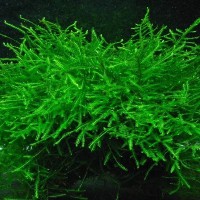
Susswassertang
Susswassertang is possibly the easiest of all aquarium plants to grow. It is certainly easier to grow than to say! Susswassertang is practically indestructible. It prefers low to almost nonexistent light. Much like the Java moss above, susswassertang doesn’t have a proper root structure. In fact, it looks more like seaweed than a traditional plant. This plant can be tricky to track down, but if you can find it I would recommend getting yourself some.
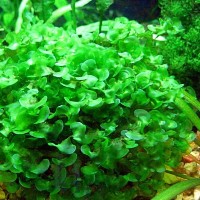
Amazon Sword
The Amazon Sword is one of the most recognizable plants in the hobby. They grow huge and are very hardy. Amazon Swords will grow under almost any light and they are not fussy about what substrate you plant them in. They are however hungry plants, and to get the best out of them they need to be given plenty of root tabs.
When Amazon Swords are happy they will send out a spike which will eventually grow several smaller sword plants along its length. Wait until these baby sword plants have roots, then cut them off the spike and plant them.
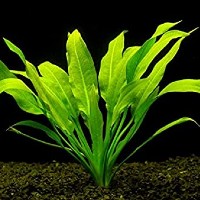
Java Fern
Java Fern is another easy-to-grow plant. It is very hardy, it just has one requirement which is, don’t plant it in the substrate. Instead, tie the rhizome to a piece of wood or rock and submerge it in the tank.
Java Fern will grow slowly, but surely, for many years. I’ve ended up with large pieces of bogwood you can’t even see because they were completely covered in Java Fern.
Java Fern isn’t too worried about light levels or fertilizers. It will grow reliably in both tropical and cold water set aquariums.

Cryptocoryne Lutea
Cryptocoryne Lutea, much like the C. wendtii above, is hardy and easy to grow. It doesn’t need too much fertilizer and it is worried about C02 being added to the tank at all. It is a slow grower and it will spread by sending runners through the substrate. A couple of clumps of this plant mixed with some tall, stem plants will make an amazing display tank.
Cryptocoryne Lutea is best used as a foreground or mid-ground plant. This Crypt is slow growing but will make an excellent addition to any aquarium.
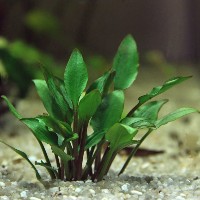
Bacopa Caroliniana
This Bacopa is said to be the easiest of all the stem plants. It grows straight up like a tree with green branches of leaves growing off it from bottom to top. The leaves are small and round and offer a nice contrast to other plants in the aquarium. To propagate the plant, simply cut off one of the stems, remove the love leaves from the freshly cut piece and plant it back in the substrate. Before you know it it will have sprouted roots and be rocketing towards the surface of the tank.
Bacopa Caroliniana can also be grown as a floating plant. Just drop a couple of stems into the aquarium and leave them. They will grow long training roots out of every part of the stem which will provide a haven for fry.
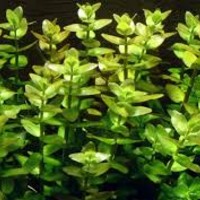
Dwarf Sagittaria
Dwarf Sagittaria is probably the easiest of all the carpeting plants to grow. If you have a good, strong light it will grow short and tight to the substrate, with light levels it will grow much longer.
Dwarf Sagittaria, which is sometimes referred to as Dwarf Sag, spreads throughout your aquarium via runners. It will benefit from both root tabs and the addition of liquid fertilizer.

Vallisneria
Vallisneria grows long and tall. It is another root feeder so will benefit from the addition of plenty of root tabs. This plant takes a while to get going, but once it does it will grow like a weed.
Vallisneria spreads by sending runners through the substrate. Plant Vallisneria towards the back of the aquarium.
This plant will fill an aquarium given the chance and it looks awesome paired with a group of Angelfish.

Pogostemon stellatus Octopus
Pogostemon stellatus Octopus is actually harder to say than it is to grow (pronounced Pogo-Stem-On Stell-R-Tus Octopus). Provide this plant with plenty of liquid fertilizer and it can grow up to 12” a week. The name octopus comes from the hundreds of finger-like leaves that grow all the way up its stems. This is another great plant if you have fry in a tank as the mass of leaves provides the perfect refuge from hungry mouths. Pogostemon stellatus Octopus will grow under any reasonable quality aquarium light.
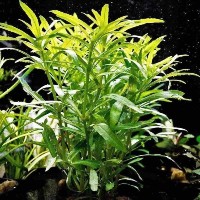
Anubias Golden
Like Java Ferns mentioned above, Anubias Golden prefers to be tied to wood or rock than planted in the substrate. This plant is a very slow grower. It may only grow 1 or 2 leaves a month. As a result, they can be a little more expensive than other plants on the list, but the extra expense is certainly worth it in my opinion. Anubias plants are generally very hardy and don’t need too much liquid fertilizer.
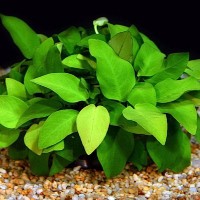
In Conclusion
If you are new to aquarium plants, there is no reason you can’t have great success, provided you pick the right varieties. Take any 3 or 4 from the list above, put them in a tank with half reasonable quality light and you’ll have an aquarium you enjoy watching for years to come.


